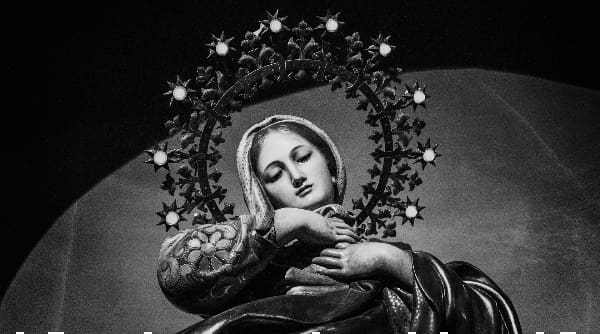Catechesis about Mary Impacted Her Life:
St. Kateri Tekakwitha
I needed a job back in the summer of 2008, and the opportunity opened up for me to work as a camp counselor at a summer camp named Camp Tekakwitha, in the Diocese of Green Bay. I didn’t know much about this young saint and I don’t think I learned much about her that summer. Her image did adorn the walls of the chapel and the dining room. Maybe we added the words “pray for us” after the mention of her name. When I worked at the camp, she was only a blessed, and not yet a saint. She was canonized in 2012. In time, St. Kateri would become one of my most powerful allies in the spiritual life.
Kateri Tekakwitha is sometimes called the Lily of the Mohawks. She was a Native American, born to a Christian Algonquin mother and a Mohawk chief in 1656. When she was only four years old, her parents and a brother died from smallpox, and Kateri survived with some scarring and partial blindness. The Jesuit missionaries arrived and began to teach the Natives about God, the Gospels, and their prayers. Kateri received the gospel with much joy and enthusiasm because she had known a little from her Christian mother. She requested Baptism and was initiated into the Catholic Faith in 1676. Kateri was not shy about her faith with her fellow people, and contrary to the wishes of her relatives, she did not want to marry. Continued persecution forced Kateri to flee that village and take up refuge near Montreal, where she could freely practice her faith.
Kateri felt called to the virginal life and today is recognized by the Church as a patroness of consecrated virgins. This love and desire for virginity was, in part, inspired by the Blessed Vigin Mary. According to one of Kateri’s biographers, Fr. Claude Chauchetière, “The virginity that Katharine [Kateri] always loved, that she preserved at the cost of her bodily life, was the reason of her frequent recourse to the Blessed Virgin; for she regarded her life as a model to be imitated as much as possible.” She was so much in love with God that she wanted to dedicate her entire life to single-hearted devotion to our Savior.
One way in which Kateri became familiar with the virginity of Mary was through the Litany of the Blessed Mother, or the Litany of Loreto, in which Mary is saluted as Queen of Virgins. This Marian prayer became for Kateri a little catechism about the Blessed Mother as it related her motherly and regal titles along with others. Kateri memorized many prayers, and the Litany of the Blessed Mother was one of them that she recited each evening after the common prayers in her cabin.
Kateri learned other Marian prayers. She was dedicated to the Angelus prayer, which is recited three times a day, at six in the morning, noon, and six in the evening. The praying of the Angelus is a recalling of the angel’s announcement to Mary and the Incarnation of Christ as the Word became flesh. Part of the Angelus also includes the repeating of Mary’s fiat: “Let it be done to me according to your word.” As Kateri strived to live her life in imitation of the Blessed Mother, the Angelus was a reminder to her of doing God’s will.
Kateri also prayed the Rosary fervently. Like St. Padre Pio, she was never seen without a rosary, and it’s said that, often when praying it, she would add a simultaneous penitential practice. Kateri also held in high regard Saturdays, a day traditionally associated with the Blessed Mother and her closeness to Christ’s tomb on Holy Saturday. On these days, Kateri would try to undertake a special act of mortification as a sign of her love, observe the day with Marian prayer, and imitate the virtues of Mary. Kateri also had a deep devotion to the Passion of Jesus. She carved a cross on a tree and would spend countless hours in prayer contemplating the love of Christ. No doubt the Sorrowful Mother who stood by the Cross also played a part in Kateri’s reflection.
I think back to those days at Camp Tekakwitha, and I remember two siblings who were homesick during the week. Being the counselor who was religious and devotional, I was asked if I would pray the Rosary with the children each night. There we sat, in front of the statue of Mary, and reflected on the life of Jesus and Mary. It was a simple practice, but looking back now it was done in imitation of St. Kateri Tekakwitha. If you don’t have Marian prayers memorized, learn them, commit them to memory and pray them often. Doing so led St. Kateri Tekakwitha, in her short life, to love Mary and to want to imitate her.
How to Love Mary Like St. Kateri Tekakwitha
- Kateri learned the Litany of Loreto and was inspired by the title Queen of Virgins. Is there a title that inspires you and can impact your life? If you are a mother, look at the Mother titles and see if there is one that you can imitate.
- Is there a certain Marian prayer or litany that you have a special love for? If so, resolve to say it every week, or even every day.
- Pray the Angelus each day. Try to do so three times a day—in the morning, at noon, and in the evening.
- How can you keep Saturday in honor of Our Lady? Think of a practical way to always be reminded of Mary’s presence on her special day of the week.
+
This article is adapted from a chapter in How They Love Mary by Fr. Edward Looney which is available from Sophia Institute Press.
Art for this post: Cover and featured image used with permission.






